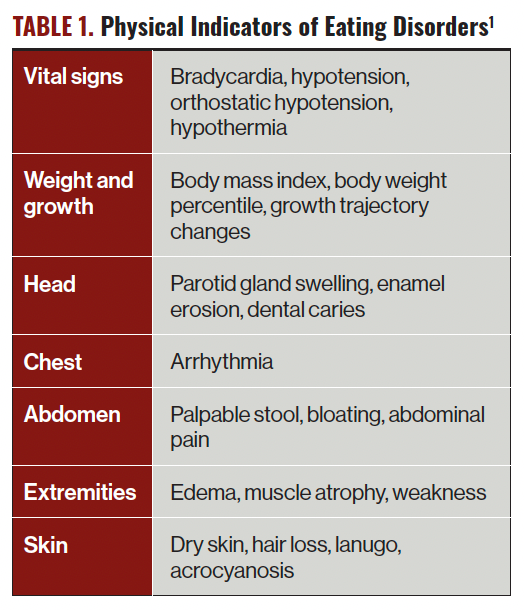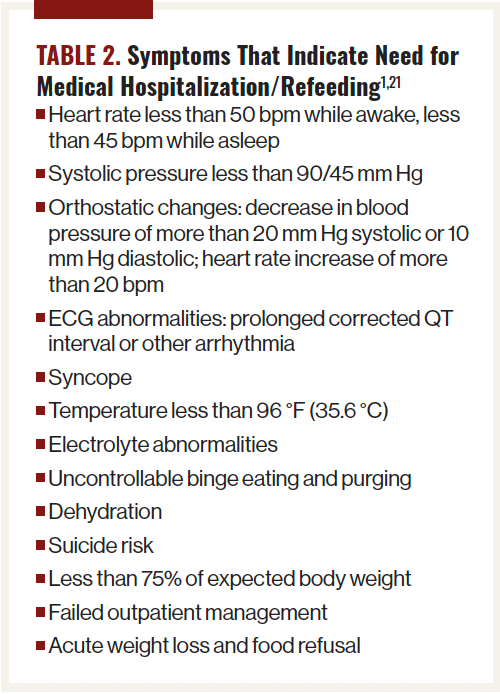Publication
Article
Psychiatric Times
The Psychiatrist’s Role in Caring for Adolescents With Eating Disorders
Author(s):
How can psychiatrists collaborate within the treatment team to help patients on the path to ongoing recovery?
Wordley Calvo Stock_AdobeStock

SPECIAL REPORT: EATING DISORDERS
A pediatrician is seeing “Allison,” a 15-year-old female patient with anorexia nervosa (AN) and a cooccurring diagnosis of generalized anxiety disorder. Her eating disorder behaviors began 2 years ago when she began having negative thoughts about her body. Fear of weight gain led her to begin skipping breakfast and lunch every day and purging after dinner. Noticing that her weight dropped, she decided to continue these behaviors to lose more weight.
After 6 months of restricted intake and purging, she dropped from 135 pounds to 95 pounds. It took her parents several months to notice the physical changes; once they did, they enrolled Allison in a residential eating disorder program.
After 2 months of treatment, she was stepped down to weekly outpatient therapy, which she has been engaged in for several months. She has restored to a healthy weight and has normal vital signs and blood work. Still, she continues to be challenged with constant anxiety and continues to need close monitoring to be sure she eats her meals. She currently denies fear of weight gain and seems to have an improved body image; however, she admits to purging 1 to 2 times per week.
When asked what triggers her purging behaviors, she cites worry about school deadlines and about her future, as well as stress in social settings. Because Allison is already engaged in routine therapy, she and her parents are asking about other treatment options. The pediatrician is talking with them about referring Allison to a psychiatrist who can treat Allison for her cooccurring anxiety disorder.
This scenario provides an example of the circumstances in which a primary care provider would consider referring a patient with an eating disorder to a psychiatrist. Patients may present to the psychiatrist at different levels of severity. They are likely to benefit from a thorough psychiatric evaluation to assess for any comorbid mood disorder or disease process that may require psychopharmacologic treatment.
The DSM-5 defines 4 main categories of eating disorders—AN, bulimia nervosa (BN), binge-eating disorder (BED), and avoidant/restrictive food intake disorder (ARFID)—along with several eating disorders noted as “other” or “atypical disorders.”1 Body weight is among the diagnostic criteria for AN only. Patients with eating disorders may be underweight, within normal range, or overweight.
Prevalence and Mortality
Analyses of prevalence and mortality rates vary widely in their findings due to differences in study methodologies, populations, definitions, and severity of illness.1 One meta-analysis found lifetime prevalence of eating disorders ranging from 1.0% to 22.7% for women and 0.3% to 0.6% for men.2 Among adolescents aged 13 to 18 years, one study found prevalence rates of 0.3% for AN, 0.9% for BN, and 1.6% for BED; the average age of onset was 12.5 years.3
A study of diagnoses in adolescent eating disorder treatment programs showed a markedly different distribution: 32% AN, 30% atypical AN, 9% BN, 19% ARFID, 6% purging disorder, and 4% others.4 Although estimates of prevalence may vary, researchers find that eating disorders typically begin in adolescence.1,3,5
AN has an estimated adult mortality rate of 5% per decade, one of the highest of all mental health conditions6; both suicide and the physical effects of nutritional deficit are implicated.7 A meta-analysis of mortality rates for eating disorders found that patients with AN had a standardized mortality ratio of 5.9 and patients with BN had a ratio of 1.9 compared with the average population.7
Long characterized as affecting primarily affluent white adolescent girls, eating disorders have in the past decade been found to also affect individuals from lower socioeconomic groups, members of nonwhite ethnic groups, preteen children, and boys.1 A 2020 study found no difference in rates of either onset of eating disorders or risk factors among ethnic groups.8
Another study found a higher incidence of BN among Hispanic youth, although the researchers urge caution in interpreting results influenced in unknown ways by treatment-seeking behaviors and social determinants of health, including immigration status.3 Research suggests that LGBTQ+ young people may be at particular risk.9
During the early months of the COVID-19 pandemic, hospitalizations for eating disorders doubled,10 and patients with these diagnoses reported significant increases in unhealthy behaviors.11 Data are not yet available on changes in prevalence as pandemic restrictions have eased.
Screening
Validated screening instruments for eating disorders include the following:
- The Eating Disorder Examination Questionnaire, which can be used with any patient older than 14 years, and the Eating Disorder Examination for Adolescents, recommended for children aged 12 to 14 years.12,13
- The 26-item Eating Attitudes Test, a screening tool originally validated with female adolescents with AN and since studied in broader populations.14
- The Silhouette Rating Scale, which assesses body size evaluation and dissatisfaction. Its advantage is that the silhouettes are devoid of ethnic and cultural details.15
Because early detection of eating disorders can lead to better patient outcomes, psychiatrists should be alert to the possibility that patients they are seeing for depression, anxiety, or other mental health concerns are also suffering from an eating disorder.
In addition to conducting routine screening for early detection, psychiatrists can perform thorough psychiatric evaluations and motivational interviews to assess patients’ readiness to change and to encourage treatment. They can also monitor patients’ weight as a step toward identifying AN.
Eating disorders are often comorbid with anxiety and mood disorders,1,16 so screening for these conditions is also important, as is screening for suicidal ideation. For patients with AN, one study suggests that lifetime suicide-attempt rates may be as high as 29.7%.7 Another study found suicidal ideation in 31.4% of adolescents with AN, 53.0% of those with BN, and 34.4% of those with BED.3
Patient Medical History
Because secrecy and denial characterize eating disorders, adolescents should be questioned alone, away from their caregivers, to encourage honesty. Questions should be specific and pointed—not just, “Do you exercise?” but rather, “What kinds of exercise do you do? How many times per week? For how many minutes? How many [miles, reps, laps]?”
Similarly, a detailed 24-hour diet history should be taken. Does the patient count calories, carbohydrates, fats, or other nutrients or ever eat in secret? Along with general intake items, clinicians should ask about body image and reproductive health (eg, date of last menstruation, length of cycle, etc).
The difference between typical adolescent eating behaviors and disordered eating may be subtle. Many teens skip meals (especially breakfast), occasionally binge, or sometimes feel dissatisfied with their bodies. Frequent deprivation, bingeing, and dissatisfaction, along with purging behaviors or secrecy around eating, are danger signs.
Physical Impact
Imbalance between the body’s needs and nutritional intake affects nearly all body systems. Table 1 highlights a few of the physical effects of eating disorders.1
Table 1. Physical Indicators of Eating Disorders1

Heart health is a significant factor because bradycardia is the most common arrhythmia and finding in patients with AN, affecting up to 95% of patients.17,18
Any health care provider who is routinely checking vital signs during a clinical visit and identifies a patient with a heart rate less than 60 beats per minute should consider ordering an electrocardiogram (ECG). Clinicians may be inclined to attribute a low heart rate to an “athletic heart,” but bradycardia due to starvation can be lethal.
Laboratory tests are performed to screen for medical complications of eating disorders and to rule out alternate diagnoses, such as gastrointestinal disease in a patient with weight loss and vomiting. Cardiac arrest can occur due to electrolyte disturbances, particularly in relation to refeeding syndrome.
One of the most important levels to check is the phosphorus level. Medical complications can include depleted adenosine triphosphate, which affects cardiac function and can lead to sudden death.19,20 Levels of phosphorus and other electrolytes are routinely monitored while patients are being treated or medically stabilized in an inpatient hospitalization setting. Once patients are receiving outpatient medical care, electrolytes are checked periodically by their primary care provider as needed.
Emergency Hospitalization
The first stage of recovery for patients with low body weight may involve hospitalization for medical stabilization. Presence of any symptoms noted in Table 2 often indicates the need for immediate medical hospitalization for refeeding.1,21
Table 2. Symptoms That Indicate Need for Medical Hospitalization/Refeeding1,21

Medical complications of reintroducing appropriate nutrition in patients experiencing self-induced starvation, which include refeeding syndrome and hypermetabolism,1 must be handled in an inpatient medical setting.
Outpatient Treatment
Psychiatrists may be in a unique position to offer access to evidence-based treatment for eating disorders, particularly if they work in an integrated setting that offers both psychiatry and psychological therapy.
Treatment of eating disorders requires a care team consisting of, at minimum, 3 to 5 professionals:
- A psychiatrist can complete a thorough evaluation for eating disorders and confirm the diagnosis using DSM-5 criteria. The psychiatrist may also complete screening and evaluation for comorbid mood and other mental health disorders.
- A psychologist can engage the patient in routine therapy, ie, family-based therapy, the first-line treatment for patients with AN,1,22 or other therapy modalities such as cognitive behavioral therapy or dialectical behavioral therapy.
- A primary care provider (pediatrician, adolescent medicine specialist, or other health care provider) can complete a medical evaluation, including weight and vital sign assessments and laboratory evaluations, and can order additional testing, such as ECGs and bone density scans, as needed.
- A dietitian can assess the patient’s nutritional requirements for growth, development, and weight restoration and develop an individualized meal plan to meet those needs.
- A social worker or case manager can help with multidisciplinary care planning and with linking the patient to a higher level of care services as needed.
To share notes and personal health information, providers need to secure permission through a release-of-information document signed by the patient if they are older than 18 years or by the legal guardian of a minor.
Outpatient treatment consisting of weekly therapy care and regular pediatric visits, with psychiatric intervention for comorbid conditions, is appropriate only for patients whose condition has been caught early or has been brought under control through more intensive intervention, as in Allison’s case. Most patients need more support.
Apart from medical hospitalization for safe refeeding, treatment options include the following:
- Intensive outpatient program: 3 to 5 hours, 3 to 5 days per week
- Partial hospitalization: 6 to 10 hours, 5 to 7 days per week
- Residential treatment: 24-hour supervision
The care team should collaborate to decide on the level of care based on the progress and severity of the disease. There is no evidence to suggest that one treatment modality is better than another for specific eating disorders.1 If residential treatment is indicated and a bed is available, the clinician team should talk with the parents about the severity of the disease and the importance of 24-hour support.
Beyond any medical stabilization that requires immediate hospitalization, treatment goals for the outpatient care team include the following23,24:
- Restore the patient to a healthy weight.
- Restore healthy eating patterns.
- Treat physical complications.
- Address dysfunctional thoughts, feelings, and beliefs.
- Address affect and behavioral regulation.
- Enlist family support.
- Prevent relapse.
As part of the care team, the psychiatrist could:
- Confirm the eating disorder diagnosis using DSM-5 criteria.
- Collaborate with the medical team on the physical/medical assessment: vitals, lab work, ECG, etc.
- Screen for suicidal ideation and potential comorbid diagnoses of depression, anxiety, and other disorders.
- Assess severity and initiate medication if indicated.
- Educate the family and enlist their support.
- Connect the patient and family to a dietician and a therapist experienced with eating disorders who can provide family-based therapy, cognitive behavioral therapy, and/or dialectical behavioral therapy.
The FDA has approved 2 medications for treating eating disorders in adults: fluoxetine (Prozac) for treating BN and lisdexamfetamine (Vyvanse) for BED.1 A study of fluoxetine in adult women with BN showed a decrease in binge-eating behaviors and vomiting, as well as improvement of any depressive symptoms.25
Many studies have been conducted on the use of psychotropic medications to treat eating disorders (particularly AN). Results have been mixed, and nearly all studies have focused on adults rather than adolescents.1
Where psychopharmacology can be most helpful is in treating comorbid anxiety and mood disorders. Comorbidity of eating disorders with other psychiatric disorders is high.1,16
For example, study of a large, nationally representative sample of 10,123 adolescents aged 13 to 18 years found comorbid mental health conditions among 55.2% of adolescents with AN, 88.0% of those with BN, and 83.5% of those with BED.3 A study of female patients aged 15 to 25 years found that those with major depressive disorder or any anxiety disorder were 4 times more likely than those without those conditions to suffer from an eating disorder.26
Evidence suggests that symptoms of mood and anxiety disorders often predate onset of eating disorders.26,27 However, physiological changes brought about by disordered eating also are likely to cause or exacerbate depression and anxiety.6 Reestablishing healthy eating habits and normal weight are likely in and of themselves to improve symptoms of depression and anxiety.6,28
Although psychotropic drugs are generally not recommended for treating adolescent eating disorders, antidepressants are often effective in treating the depression and anxiety that may accompany eating disorders. For example, treating depression or anxiety may help patients be more receptive to the skills and behavior changes to which they are introduced during therapy.
A literature review in adult women with AN found that selective serotonin reuptake inhibitors, although not effective in treating AN itself, can improve symptoms of cooccurring depression and help prevent relapse in some patients who have restored their weight.28
The best evidence supports use of fluoxetine; citalopram (Celexa), sertraline (Zoloft), or mirtazapine (Remeron) may also be effective. Use of tricyclic antidepressants and monoamine oxidase inhibitors is not recommended in patients recovering from AN because of safety concerns, and bupropion is contraindicated by the FDA.28
Patient and Family Communication
Caregivers are key partners, and their help, should be enlisted. Patients who are severely malnourished or underweight or have severe restricting or purging behaviors often need to suspend exercise until they have developed a healthier relationship with food. Parents may need to take the lead on preparing meals, and they should closely monitor consumption.
Shared and unified messaging from the entire treatment team can help build trust with the family. For example, if all team members agree that the patient meets criteria for a diagnosis of AN, they will engender more trust with the family than if the psychiatrist diagnoses AN and the pediatrician diagnoses ARFID. Families who trust their child’s treatment team are more likely to engage in recommended behavioral treatments.
Lifelong Recovery
Short-term recovery from restrictive eating disorders typically includes achieving at least 90% of median body weight for the patient’s age and height.1 Other markers of recovery, such as a realistic body image and healthy relationship to food, are more difficult to measure but equally important for the long-term prognosis. Adolescents may be more likely to achieve this level of recovery than adults; one study put the adolescent recovery rate at 70%.29
Another study put the adolescent recovery rates, defined by median body weight, at 64% for patients with AN, 82% for patients with atypical AN, and only 43% for patients with ARFID.30 In a study of adolescents who underwent a year-long treatment program for AN, only one-third were in full remission after 1 year.31
There is limited evidence of recovery from BN, BED, and purging disorder. This suggests that both short-term and long-term recovery rates are even lower than for AN and ARFID.1
For most patients, guarding against relapse is a lifelong task. Early diagnosis and treatment are keys to success.1 Psychiatrists can collaborate within the treatment team to help patients and caregivers on the path to ongoing recovery.
Dr Reese is director of the Adolescent and Young Adult Specialty Clinic at Johns Hopkins All Children’s Hospital in St Petersburg, Florida. As a member of the faculty of The REACH Institute, she teaches pediatric primary care providers to diagnose and treat common mental health conditions.
References
1. Hornberger LL, Lane MA; Committee on Adolescence. Identification and management of eating disorders in children and adolescents. Pediatrics. 2021;147(1):e2020040279.
2. Lindvall Dahlgren C, Wisting L, Rø Ø. Feeding and eating disorders in the DSM-5 era: a systematic review of prevalence rates in non-clinical male and female samples. J Eat Disord. 2017;5:56.
3. Swanson SA, Crow SJ, Le Grange D, et al. Prevalence and correlates of eating disorders in adolescents. Results from the national comorbidity survey replication adolescent supplement. Arch Gen Psychiatry. 2011;68(7):714-723.
4. Fisher M, Gonzalez M, Malizio J. Eating disorders in adolescents: how does the DSM-5 change the diagnosis? Int J Adolesc Med Health. 2015;27(4):437-441.
5. Marzilli E, Cerniglia L, Cimino S. A narrative review of binge eating disorder in adolescence: prevalence, impact, and psychological treatment strategies. Adolesc Health Med Ther. 2018;9:17-30.
6. Marvanova M, Gramith K. Role of antidepressants in the treatment of adults with anorexia nervosa. Ment Health Clin. 2018;8(3):127-137.
7. Arcelus J, Mitchell AJ, Wales J, Nielsen S. Mortality rates in patients with anorexia nervosa and other eating disorders. A meta-analysis of 36 studies. Arch Gen Psychiatry. 2011;68(7):724-731.
8. Cheng ZH, Perko VL, Fuller-Marashi L, et al. Ethnic differences in eating disorder prevalence, risk factors, and predictive effects of risk factors among young women. Eat Behav. 2019;32:23-30.
9. Watson RJ, Adjei J, Saewyc E, et al. Trends and disparities in disordered eating among heterosexual and sexual minority adolescents. Int J Eat Disord. 2017;50(1):22-31.
10. Asch DA, Buresh J, Allison KC, et al. Trends in US patients receiving care for eating disorders and other common behavioral health conditions before and during the COVID-19 pandemic. JAMA Netw Open. 2021;4(11):e2134913.
11. Termorshuizen JD, Watson HJ, Thornton LM, et al. Early impact of COVID-19 on individuals with self-reported eating disorders: a survey of ~1,000 individuals in the United States and the Netherlands. Int J Eat Disord. 2020;53(11):1780-1790.
12. Eating Disorder Examination Questionnaire (EDE-Q). Child Outcomes Research Consortium. Accessed November 14, 2022. https://www.corc.uk.net/outcome-experience-measures/eating-disorder-examination-questionnaire-ede-q/
13. Berg KC, Peterson CB, Frazier P, Crow SJ. Psychometric evaluation of the eating disorder examination and eating disorder examination-questionnaire: a systematic review of the literature. Int J Eat Disord. 2012;45(3):428-438.
14. Papini NM, Jung M, Cook A, et al. Psychometric properties of the 26-item eating attitudes test (EAT-26): an application of Rasch analysis. J Eat Disord. 2022;10(1):62.
15. Lombardo C, Cerolini S, Esposito RM, Lucidi F. Psychometric properties of a Silhouette Rating Scale assessing current and ideal body size and body dissatisfaction in adults. Eat Weight Disord. 2022;27(3):1089-1097.
16. Lin JA, Jhe G, Vitagliano JA, et al. The association of malnutrition, illness duration, and pre-morbid weight status with anxiety and depression symptoms in adolescents and young adults with restrictive eating disorders: a cross-sectional study. J Eat Disord. 2021;9(1):60.
17. Mehler PS, Brown C. Anorexia nervosa – medical complications. J Eat Disord. 2015;3:11.
18. Yahalom M, Spitz M, Sandler L, et al. The significance of bradycardia in anorexia nervosa. Int J Angiol. 2013;22(2):83-94.
19. Håglin L. Hypophosphataemia in anorexia nervosa. Postgrad Med J. 2001;77(907):305-311.
20. Mehanna HM, Moledina J, Travis J. Refeeding syndrome: what it is, and how to prevent and treat it. BMJ. 2008;336(7659):1495-1498.
21. Society for Adolescent Health and Medicine; Golden NH, Katzman DK, Sawyer SM, et al. Position paper of the Society for Adolescent Health and Medicine: medical management of restrictive eating disorders in adolescents and young adults. J Adolesc Health. 2015;56(1):121-125.
22. Rienecke RD. Family-based treatment of eating disorders in adolescents: current insights. Adolesc Health Med Ther. 2017;8:69-79.
23. Rome ES, Strandjord SE. Eating disorders. Pediatr Rev. 2016;37(8):323-336.
24. National Collaborating Centre for Mental Health. Eating Disorders: Core Interventions in the Treatment and Management of Anorexia Nervosa, Bulimia Nervosa and Related Eating Disorders. British Psychological Society; 2004.
25. Fluoxetine in the treatment of bulimia nervosa. A multicenter, placebo-controlled, double-blind trial. Fluoxetine Bulimia Nervosa Collaborative Study Group. Arch Gen Psychiatry. 1992;49(2):139-147.
26. Garcia SC, Mikhail ME, Keel PK, et al. Increased rates of eating disorders and their symptoms in women with major depressive disorder and anxiety disorders. Int J Eat Disord. 2020;53(11):1844-1854.
27. Çöpür S, Çöpür M. Olanzapine in the treatment of anorexia nervosa: a systematic review. Egypt J Neurol Psychiatry Neurosurg. 2020;56:60.
28. Marvanova M, Gramith K. Role of antidepressants in the treatment of adults with anorexia nervosa. Ment Health Clin. 2018;8(3):127-137.
29. Steinhausen HC. Outcome of eating disorders. Child Adolesc Psychiatr Clin N Am. 2009;18(1):225-242.
30. Forman SF, McKenzie N, Hehn R, et al. Predictors of outcome at 1 year in adolescents with DSM-5 restrictive eating disorders: report of the national eating disorders quality improvement collaborative. J Adolesc Health. 2014;55(6):750-756.
31. Lock J, Le Grange D, Agras WS, et al. Randomized clinical trial comparing family-based treatment with adolescent-focused individual therapy for adolescents with anorexia nervosa. Arch Gen Psychiatry. 2010;67(10):1025-1032.







